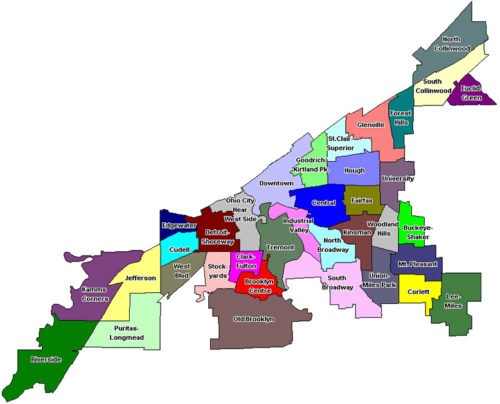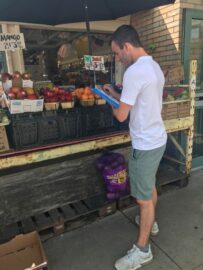Neighborhood Environmental Assessment Project
The Neighborhood Environmental Assessment Project (NEAP) is a place-based surveillance data collection project intended to provide community partners and researchers with valuable data about the built environmental landscape of Cleveland in relation to healthy lifestyles.
The project started in 2012 with the Food Retail Project as a way to introduce student interns to all the neighborhoods of Cleveland by having them annually collect data on all the food retailers within the city. Since then, the project has periodically inventoried community gardens and other urban agriculture sites (i.e. market gardens, farmers markets); parks and playgrounds; water fountains; the school food environment of Cleveland Metropolitan School District K-8 schools; and select street segments of Cleveland and select suburbs utilizing a neighborhood assessment inventory. The primary project of NEAP currently is CIFTR (Cleveland Inventory of Food and Tobacco Retail).
The primary goals NEAP are to gain a better understanding of the built environmental landscape of Cleveland, and to provide valuable data to both community partners and researchers. We continue with CIFTR collection annually each summer in order to update our historical database of Cleveland retailers to understand how the food environment changes over time
Why is this important to our community?
Data collected through NEAP are a valuable resource for our community. It provides timely and relevant data around the local built environment, typically assets within the community. It helps both community partners and researchers alike in their efforts to develop and support initiatives intending to improve the health of Cleveland residents and their access to environments supportive of a healthy lifestyle. This project supports the mission of the Prevention Research Center for Healthy neighborhoods by providing critical data that assists in informing sustainable strategies and interventions to prevent and reduce the burden of chronic disease.
Project Activities & Methods
The following NEAP methodologies aid in the completion of inventories of various environmental characteristics including:
In-person visits to locations to inventory items
Ground-truthing of neighborhoods to update prior year’s stores and discover new food and tobacco retail locations
Data entry of inventory
Maintenance of inventory database
Our Inventories
-
Community Garden Inventory
-
Farmer's Market Inventory
-
Parks, Playgrounds, and Green Space Inventory
-
Water Fountain Inventory
-
School Food Environment Inventory
-
Neighborhood Attribute Inventory of Select Street Segments Within Cleveland and Various Surrounding Suburbs
Communities of Focus
All neighborhoods within the City of Cleveland and select inner-ring suburbs

Team & Community Partners
NEAP is conducted by a large, fluid group of student interns who serve as data collectors. NEAP is led by Drs. Borawski and Trapl, with implementation and analytics support from Rachel Gardenhire, MS, Stephanie Pike-Moore, PhD, Matthew Kucmanic, MA, MPH and Laura Fernandez, MPH.
Collaborators & Partners
- Place-specific partners (Cleveland Metropolitan School District, Parks Service, Food Retail Owners)
- Freeman Center for Digital Scholarship (provides funding for Food Retail Project)
Grant Periods & Data Collection Timelines
Grant Period(s)
The following grants have supported NEAP over the years
- PRCHN/CDC grant (U48DP001930, U48DP005030)
- REACH grant (1U58DP005851)
- IMPACT grant (4U01HL103622)
- Angela Bowen Williamson Endowment
- CWRU SOM Department of Population and Quantitative Health Sciences
- Freedman Center for Digital Scholarship – Freedman Scholar Award
Timelines for Data Collection
- Food and Tobacco Retail: Summers of 2012 – Present (No 2020 data was collected due to the COVID-19 pandemic)
- Neighborhood Attribute Inventory: 2012- 2016
- School Food Environment Assessments: 2012, 2016
- Community Gardens:
- Farmer’s Markets:
- Parks, Playgrounds, Green Spaces:
- Water Fountains:

